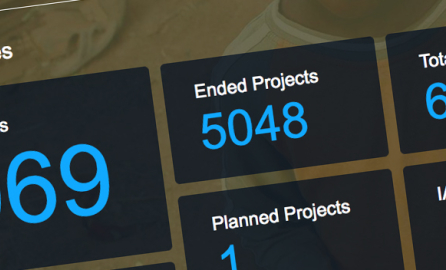In development and humanitarian contexts, access to accurate and timely information is crucial for distributing aid and reporting on its results. Frequently, however, the data made available by donors and implementing partners comes in different formats and lacks comprehensiveness and consistency, making it impossible to compare it with data sets from other organisations.
The International Aid Transparency Initiative (IATI) is an open data standard for publishing information on development, allowing aid organisations to publish information in a uniform and more accessible format. The European Commission has been publishing its foreign aid data to IATI since 2011. Recently, the Directorate General for International Cooperation and Development (DEVCO) introduced a new training course to help staff at headquarters and in EU Delegations make the most use of the standard in their everyday work.
The training is led by Steven Flower, who worked directly for IATI and now co-runs the Open Data Services Co-operative in the UK. Mr Flower spoke to Capacity4dev about how development workers can benefit from using IATI data in the field.
Capacity4dev (C4D): What is IATI?
Steven Flower (SF): The International Aid Transparency Initiative, or IATI for short, is a voluntary, multi-stakeholder initiative that makes information on aid development cooperation and humanitarian activity accessible, comparable and, most importantly, easy to use.
It dates back to the Third High Level Forum on Aid Effectiveness in 2008, where various donors, the UN, the World Bank, and many other development actors agreed on the need for a common format for sharing and accessing data.
A quick introduction to the International Aid Transparency Initiative (IATI):
At the beginning, IATI held consultations with government and civil society stakeholders from over 70 partner countries about their information needs. The consultations confirmed that the priority needs were for timely, up-to-date and reliable information on current and future development cooperation. The partners also stressed the need for better coverage, including information from non-traditional providers, such as foundations, NGOs and technical cooperation providers.
From that came the IATI Standard, which helps the various organisations produce data in a uniform and open-access format, making it easy to combine and compare the data sets from different partners.
|
What is the IATI Standard? The IATI Standard is a format and framework for publishing data on development cooperation activities, intended to be used by all organisations in development, including government donors, private sector organisations, and national and international NGOs. Organisations implement IATI by publishing their aid information in IATI’s agreed electronic format (XML) – usually on their website – before linking it to the IATI Registry. The Registry acts as an online catalogue and index of links to all of the raw data published to the IATI Standard. For more information visit the IATI Standard’s website. |
C4D: How many organisations publish their data through IATI?
SF: When I first started working for IATI in 2011, there were only four organisations publishing data. Today, there are around 600, and they range from large institutions like the European Commission and the World Bank, to small NGOs that only work on one or two projects.
These organisations are all involved at different levels of the development chain, from donors to implementing partners. And we’ve seen increased involvement on all sides. The European Commission and its various Directorates, for example, have been publishing data with the IATI Standard, as do more and more Member States. The Italian agency for overseas co-operation (AICS), for instance, has recently started outputting their data using the standard.
Steven Flower on making IATI Standard work across the development spectrum:
C4D: How can aid workers make use of that data?
SF: Because IATI data covers so many participating organisations, the chances are, as an aid worker, you’ll be able to find data on the country you work in. With that information, you can start figuring out what organisations are involved where, who they work with, what types of results are coming out of those activities, and so on.
What’s really useful here, is that you can start to trace the data starting with the donors, through the bilateral levels, all the way to the implementing organisations. And as you begin to see how aid reaches the various parts of that chain, you realise the relationship between the different organisations and how and where the funds are being implemented. It should be said that it isn’t always the case though - as data quality can differ between organisations. However, the general trend is that data gets more useful as more people use it, and provide feedback.
And that‘s the nice thing about IATI – you can view data sets from the World Bank alongside those of even the smallest NGO. This is particularly interesting if they happen to be working on the same topic or theme, or in the same country.
And it doesn‘t mean that you have to download lots of datasets to do that. There are different websites and tools that let you look at that information and begin to query, map and graph it.
C4D: What kind of tools?
SF: In our training with the European Commission, for example, we use the D-Portal. It takes all the IATI data and groups it by countries, sectors, and so on. This gives us information at an aggregate level, which we can then narrow down to particular projects, and see if there are any connections between them.
Say you’re working in a specific country. The website is easy to search through and you can quickly get to a subset of activities that are of interest to you. What people often end up doing is to download the data into a spreadsheet to analyse it much further in their own time, using their own skills and software.
So it‘s not necessarily about having a single tool that does it all, but the website does let you filter through the 600 organisations involved – which, combined, represent close to half a million projects – and find what’s useful to you. It’s an excellent starting point.
C4D: Can you think of any examples where the standard has been used in the field?
SF: In Bangladesh, the national government is importing IATI data into their systems to compare it with the datasets they already have in their Aid Information Management Systems (AIMS), to see where they can improve the quality of their donors’ data with what they know locally. That’s going to be a really interesting intersection between what’s published and what’s known locally and how AIMS can begin to increase the quality of data at a local level, by using the big datasets available from the European Commission, for example, to gain a head start.
Another initiative that’s quite interesting is called the Initiative for Open Agriculture Funding. The programme really pushes the boundaries of how IATI data is used to find out how machines can help us automate certain process and do more with the information we already have – create different classifications and geographies, for example.
C4D: What is the difference between the IATI Standard and similar instruments like the Common Reporting Standard (CSR)?
|
What is the CRS? The Creditor Reporting System's (CRS) Aid Activity database basic data for analysing where aid goes, what purpose it serves and what policies it aism to implement. Records are available on individual projects and programmes, from 1995 onwards. Focus is on financial data but some descriptive information is also made available. For more information visit the OECD website |
SF: Before IATI, the main source of information on aid projects was the OECD CRS. The CRS system is extremely useful, but only represents a selection of bilateral donors and others, and there’s a time lag for the data to be audited and published. IATI implements some of the CRS elements but has a focus on data being more frequent and “real-time”, and published by a range of actors.
Both datasets, however, are very useful in that they’ve got different characteristics. IATI data is very indicative, somewhat real-time and wide-ranging in nature and scope, whereas the OECD CRS data is carefully vetted. That does mean, however, that a lot of the OECD CSR data is not timely enough. By the time you get access to it, it might be 1-2 years out of date – making it hard to use for timely decision-making. Timeliness doesn’t matter that much for statistical purposes, but it is crucial for effective aid management.
Think of CRS as audited accounts, whereas IATI is the cash book of what‘s happening now. Many organisations and analysts use both data sets to try and get a flavour of what‘s going on, what‘s already happened and where investments still need to take place.
One of the real aims of the IATI Standard is to make the data forward-looking – to show not just what has happened, but also what‘s going to happen. That forward-looking nature of IATI data is really helpful to organisations that want to figure out where aid is likely to be committed, in which sector or parts of the country, for example.
Steven Flower on how the IATI Standard is governed:
C4D: How frequently is the data in the IATI Registry updated and how do you ensure its quality?
SF: The aim of IATI data is that it’s continuously updated. Once it’s been published, organisations like the European Commission, for example, might update it once a month, but there are some that do it every night.
It really depends on how those organisations are set up, but the key thing they have in common is that they all keep on top of that information and update it regularly. The IATI community recommends that it’s done at least once a quarter.
There are several way to ensure the data remains high quality. On a centralised level, for instance, the IATI secretariat and technical team maintain a dashboard that lets you look at all the data sets and spot errors or mismatches.
Another, more obvious way, is relying on the actual users and producers of the data. Quite often, those who end up using the data work for the organisation that publishes it. As a member of an EU Delegation, for example, you could pick up on any inconsistencies in the data put out by the European Commission’s headquarters in Brussels.
Then, there are the advocacy organisations, such as Publish What You Fund, that conduct what’s called an aid transparency index, where they biennially compare the key donors and development organisations. If you want to move up in that index – and many organisations do – you’ll put in a lot of effort into ensuring you publish only accurate data.
Stay tuned to Capacity4dev for more information on DEVCO’s training on IATI data.
This article was written by Bartosz Brzezinski, the Editorial Coordinator at Capacity4dev.





Log in with your EU Login account to post or comment on the platform.